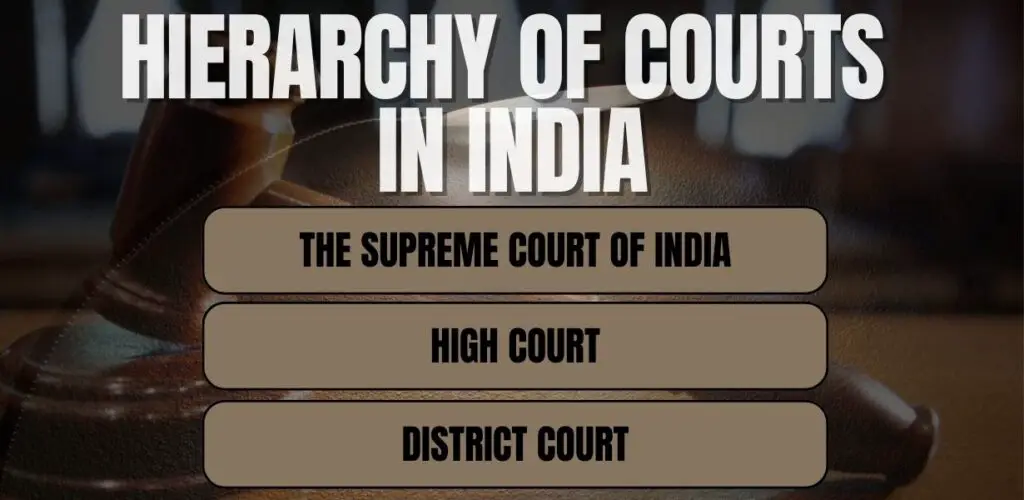Hierarchy of Courts in India: Understanding the Structure and Jurisdiction

The hierarchy of courts in India is an essential aspect of the Indian Judiciary system. The Indian Judiciary has a unified structure, and the courts are divided into mainly three categories: the lower court, the middle court, and the top court. The top court is termed as the Supreme Court, the middle court is the High Court, and the lower court is the District Court.
The Indian Judiciary has been established with the objective of providing justice to every citizen of the country. The hierarchy of courts in India is designed to ensure that justice is delivered in a fair and impartial manner. The lower courts have jurisdiction over specific areas, while the higher courts have wider jurisdiction. The Supreme Court is the highest court in the country, and its decisions are binding on all other courts in the country.
The hierarchy of courts in India plays a crucial role in ensuring that the administrative laws are enforced in a fair and just manner. The Indian Judiciary has the power to interpret the laws and ensure that they are implemented in a way that is consistent with the Constitution of India.
Page Contents
Courts in India
India’s judicial system has a long and complex history, with influences from various sources. The current system is based on the common law system introduced by the British East India Company during colonial rule.
The first courts in India were established by the British in the early 18th century. These courts were primarily concerned with resolving disputes between British merchants and Indian traders. However, over time, the British began to establish courts to deal with criminal cases and other legal matters.
The Indian judiciary was reformed after India gained independence in 1947. The Constitution of India, which came into effect on January 26, 1950, established a single unified judiciary for the entire country. The Constitution also provided for the independence of the judiciary, ensuring that judges were appointed by an independent body and were not subject to political pressures.
The hierarchy of courts in India was also established by the Constitution. The Supreme Court of India is the highest court of the land and is responsible for interpreting the Constitution and other laws. Below the Supreme Court are the High Courts of various states, which have jurisdiction over their respective states.
The subordinate courts, which include district courts and lower courts, are responsible for hearing cases at the local level. In addition to these courts, there are also various tribunals and special courts that deal with specific areas of law, such as labour laws or taxation.
Overall, the Indian judiciary has come a long way since its colonial origins. Today, the hierarchical system that is designed to ensure justice for all citizens of India.
Indian Administrative Law
Indian Administrative Law refers to the laws and regulations that govern the functioning of the executive branch of the government. This branch is responsible for implementing and enforcing laws passed by the legislative branch. The Indian Administrative Law is based on the principles of natural justice and fairness.
The Central Government is responsible for administering the Union Territories and the National Capital Territory of Delhi. The State Governments are responsible for administering the States. The Governor is the head of the State Government and is appointed by the President of India.
The administrative structure of India is divided into two levels, namely the Central Government and the State Governments. The Central Government is responsible for matters of national importance, while the State Governments are responsible for matters of local importance.
Indian Administrative Law is an essential aspect of the Indian legal system. It defines the powers and functions of various administrative bodies, as well as the jurisdiction of various courts. The principles of natural justice and fairness are at the heart of the Indian Administrative Law.
Hierarchy of Courts in India

India has a well-established judicial system that is divided into three categories: the Supreme Court of India, High Courts, and Subordinate or Lower Courts in Districts. Each court has its specific jurisdiction and powers, and they function according to the set hierarchy of the courts.
Supreme Court of India
The Supreme Court of India is the highest and final court of appeal in the country. It is developed under Part V, Chapter IV of the Constitution of India. Articles 124 to 147 lays down the provisions for the composition and jurisdiction of the Supreme Court.
The original Constitution of 1950 established a Supreme Court consisting of a Chief Justice and 7 other judges, with the option for Parliament to increase this number. Initially, all judges sat together to hear cases. However, as the workload grew and cases began to pile up, Parliament gradually increased the number of judges of the Supreme Court. The number rose from 8 in 1950 to 11 in 1956, 14 in 1960, 18 in 1978, 26 in 1986, 31 in 2009, and finally to the current strength of 34 in 2019.
| Year | Number of Judges |
|---|---|
| 1950 | 8 |
| 1956 | 11 |
| 1960 | 14 |
| 1978 | 18 |
| 1986 | 26 |
| 2009 | 31 |
| 2019 | 34 |
The Supreme Court has original, advisory, and appellate jurisdiction. It is the custodian of the Constitution and has the power of judicial review. It can issue writs such as mandamus, prohibition, certiorari, habeas corpus, and quo warranto.
Only English is used in the proceedings of the Supreme Court, as mandated by the Supreme Court Rules of 1966 and 2013. These rules were created under Article 145 of the Constitution to govern the practice and procedure of the Supreme Court.
High Courts
As per Article 214 of the Indian Constitution, the High Court is the highest judicial authority in each state. However, Article 231 allows for the creation of a common High Court for multiple states or a combination of states and union territories.
Currently, there are 25 High Courts in India, with six of them having jurisdiction over more than one state or union territory. Delhi, as a union territory, has its own High Court. Each High Court is headed by a Chief Justice and comprises other judges appointed by the President of India.
The Supreme Court and High Courts play a crucial role as guardians and overseers of the fundamental rights and freedoms enshrined in the Indian Constitution. They bear an immense responsibility in this regard.
Over the years, the superior judiciary has effectively safeguarded the fundamental rights of citizens and vulnerable groups against the potential excesses of a democratic system that may be driven by momentary passions. In doing so, the judiciary has relied heavily on the Directive Principles of State Policy.
Subordinate or Lower Courts in Districts
The subordinate or lower courts in districts are the lowest level of courts in India. They are presided over by judges who are appointed by the State Government. The subordinate courts have original jurisdiction in both civil and criminal cases, and their decisions can be appealed to the High Court.
The table below shows the hierarchy of courts in India from the top level to the bottom level.
| Level of Court | Type of Court |
|---|---|
| Top Level | Supreme Court |
| Middle Level | High Court |
| Bottom Level | Subordinate or Lower Courts in Districts |
The chart below shows the jurisdiction and capability of punishment changes at every level and in every court.
| Court | Jurisdiction | Capability of Punishment |
|---|---|---|
| Supreme Court | Original, advisory, and appellate jurisdiction | Can issue writs and has the power of judicial review |
| High Court | Appellate jurisdiction over subordinate courts | Can issue writs to enforce fundamental rights |
| Subordinate or Lower Courts in Districts | Original jurisdiction in both civil and criminal cases | Can impose fines and imprisonment |
Administration of Justice
The administration of justice in India is carried out by the judiciary. The judiciary system is independent of the executive and legislative branches of the government.
Precedence
The Supreme Court of India has precedence over all other courts in the country. The High Courts have precedence over the subordinate courts within their respective jurisdictions.
Lok Adalat
Lok Adalat are alternative dispute resolution mechanisms that are intended to provide speedy and inexpensive justice to the people. They are organized by the judiciary and are presided over by retired judges, social activists, and other experts. Lok Adalats can settle disputes through negotiation, conciliation, and mediation.
The hierarchy of courts in India is well-established, and each court has its specific jurisdiction and powers. The administration of justice in India is carried out by an independent judiciary, and Lok Adalats provide alternative dispute resolution mechanisms.
Juvenile Courts
Juvenile courts in India are set up to handle cases involving minors who have committed crimes or are in need of protection. These courts are headed by a judge who specializes in juvenile cases and is responsible for ensuring that the child’s best interests are protected.
The purpose of juvenile courts is to provide a separate system of justice for minors that takes into account their unique needs and circumstances. The goal is to rehabilitate the child and prevent them from committing further crimes, rather than punishing them for their actions.
Juvenile courts have jurisdiction over children under the age of 18 who have committed crimes or are in need of protection. The court can order the child to receive counseling, attend a rehabilitation program, or be placed in a juvenile detention center.
The proceedings in a juvenile court are confidential and are not open to the public. This is to protect the privacy of the child and to prevent their criminal record from following them into adulthood.
Juvenile courts in India are an important part of the justice system that is designed to provide a separate system of justice for minors. The goal is to rehabilitate the child and prevent them from committing further crimes, rather than punishing them for their actions.
Special Courts
Special Courts in India have been established under various statutes to deal with specific types of cases. These courts have been set up to ensure speedy and efficient disposal of cases and to provide specialized expertise in dealing with complex legal issues.
The purpose of Special Courts is to provide a specialized forum for the trial of certain types of cases, which require specific expertise and knowledge. These courts are established to deal with cases related to economic offenses, environmental offenses, cyber crimes, and other specialized areas of law.
Special Courts are headed by a judge appointed by the Chief Justice of the High Court. The judge must have expertise and experience in the relevant area of law. The judge is responsible for conducting the trial and delivering the verdict in accordance with the law.
Some of the important Special Courts in India are:
- Special Courts under the Companies Act, 2013: These courts are empowered to try all offenses related to the Companies Act, 2013. They have been established to ensure speedy disposal of cases related to corporate offenses.
- Special Courts under the Prevention of Corruption Act, 1988: These courts are established to deal with cases related to corruption and other offences under the Prevention of Corruption Act, 1988.
- National Green Tribunal: This tribunal has been established to deal with cases related to environmental offences. It has the power to hear cases related to the protection and conservation of the environment.
- Cyber Appellate Tribunal: This tribunal has been established to deal with cases related to cyber crimes and other offences under the Information Technology Act, 2000.
Special Courts in India have been established to provide a specialized forum for the trial of certain types of cases. These courts have been set up to ensure speedy and efficient disposal of cases and to provide specialized expertise in dealing with complex legal issues.
The Tribunals
Tribunals are specialized courts that are set up to deal with specific types of cases. They are usually established to deal with disputes that arise in areas such as taxation, labor, environment, and intellectual property. The tribunals are an important part of the judicial system in India as they provide a quicker and more efficient way of resolving disputes.
The purpose of the tribunals is to provide a specialized forum for resolving disputes that arise in specific areas. The tribunals are set up to deal with cases that require specialized knowledge and expertise. For example, the Income Tax Appellate Tribunal (ITAT) is set up to deal with disputes related to income tax. Similarly, the National Green Tribunal (NGT) is set up to deal with disputes related to environmental issues.
The tribunals are an important part of the judicial system in India. They provide a specialized forum for resolving disputes that arise in specific areas. The judges for the tribunals are appointed through a transparent process to ensure that the best candidates are selected.
Alternative Dispute Resolution
Alternative Dispute Resolution (ADR) is a method of resolving disputes outside of the traditional court system in India. ADR is a voluntary process that allows parties to resolve disputes in a less formal and more collaborative manner. ADR is an effective way to resolve disputes quickly and efficiently, and it is often less expensive than traditional litigation.
There are several types of ADR that parties can choose from, including mediation, arbitration, and negotiation. Mediation is a process in which a neutral third party facilitates communication between the parties to help them reach a mutually acceptable agreement. Arbitration is a process in which a neutral third party makes a binding decision on the dispute. Negotiation is a process in which the parties work together to reach a mutually acceptable agreement.
ADR is becoming increasingly popular in India due to the high cost and time-consuming nature of traditional litigation. ADR can be used to resolve a wide range of disputes, including commercial disputes, family disputes, and disputes between neighbors.
In India, the Government has taken steps to promote the use of ADR. The Indian Arbitration and Conciliation Act of 1996 provides a legal framework for the use of ADR in India. The act encourages parties to resolve disputes through ADR and provides a legal basis for the enforcement of ADR agreements.
ADR is a valuable tool for resolving disputes in India. It allows parties to resolve disputes quickly and efficiently, and it can be less expensive than traditional litigation. Parties should consider ADR as an option when faced with a dispute to save their time and money.
Functions of Indian Judiciary
The Indian Judiciary is an integral part of the Indian Legal System and plays a vital role in ensuring justice is served fairly and impartially. The Judiciary has a multitude of functions that it performs to maintain the rule of law and uphold the Constitution. The following are some of the main functions of the Indian Judiciary:
Interpretation of Law
One of the primary functions of the Judiciary is to interpret the law. The Judges interpret the laws and the Constitution to ensure that they are consistent with the principles of justice and fairness. This interpretation helps to resolve disputes and prevent any ambiguity or confusion in the application of the law.
Guardian of the Constitution
The Indian Judiciary is the guardian of the Constitution and ensures that the fundamental rights of the citizens are protected. The Judiciary ensures that the laws passed by the Legislature are consistent with the Constitution and do not violate the fundamental rights of the citizens.
Resolving Disputes
The Judiciary also plays a crucial role in resolving disputes between individuals, organizations, and the State. The Judiciary has the power to hear appeals from lower courts and ensure that justice is served in a fair and impartial manner.
Advisory Function
The Judiciary also has an advisory function and provides advice to the government on legal matters. The Judiciary ensures that the laws passed by the Government are consistent with the Constitution and do not violate the fundamental rights of the citizens.
Administrative Functions
The Judiciary also performs various administrative functions, including the appointment of Judges, court staff, and the management of court proceedings. The Judiciary ensures that the courts function efficiently and effectively to provide justice to the citizens.
The Indian Judiciary plays a vital role in upholding the rule of law and ensuring that justice is served fairly and impartially. The Judiciary has a multitude of functions that it performs to maintain the integrity of the Indian Legal System and protect the rights of the citizens.
Conclusion
To sum up, the Indian judicial system is a pyramidal structure with the Supreme Court at the top, followed by High Courts, and then lower courts. The Supreme Court is the highest court of appeal and has the power to interpret the Constitution and hear appeals from lower courts. The High Courts have jurisdiction over the states in which they are located, while the lower courts handle matters at the district and subordinate levels.
The Indian legal system has been influenced by local customs and religion, and the current structure of the courts reflects this. The Supreme Court of India has established a reputation for itself and has become well known in the jurisprudential world map of law and justice. The Court’s interpretation of the right to equality and right to life has made it a trendsetter worthy of the most liberal egalitarian judges.
Overall, the Indian judicial system is a structure that has evolved over time. While there are certainly challenges and areas for improvement, the system is designed to provide justice and ensure the rule of law in the country.
What Next?
We at studease encourage students to prepare well and stay informed. For more Content, Join our Telegram group to stay updated.
Join: studease Telegram Channel
Follow us: instagram
Subscribe: studease Youtube Channel
Download studease App:
👉 Android: https://edustan.page.link/Wbe5
👉 iOS users: Download Myinstitute app, enter org code – studease







